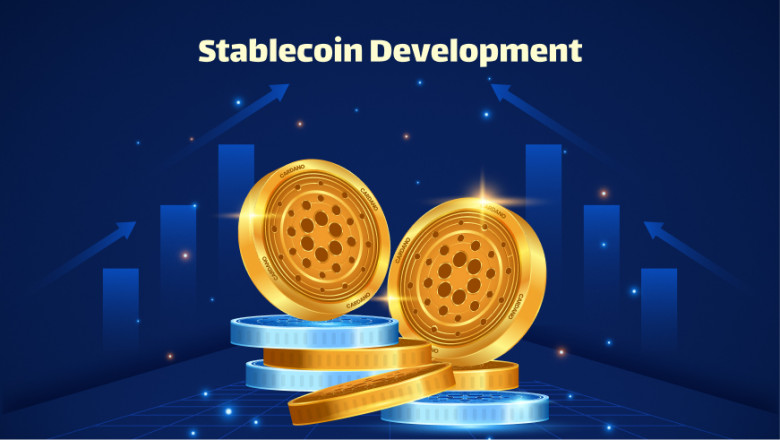views
In the evolving world of digital currencies, stable coin development has emerged as a cornerstone for bridging the gap between traditional finance and decentralized blockchain systems. Unlike volatile cryptocurrencies such as Bitcoin or Ethereum, stablecoins are pegged to real-world assets like fiat currencies, commodities, or other cryptocurrencies, providing price stability and trust—two crucial elements in financial ecosystems.
What is Stable Coin Development?
Stable coin development refers to the process of designing, building, and launching a cryptocurrency that maintains a stable value over time. This development involves integrating smart contracts, selecting collateral mechanisms, ensuring regulatory compliance, and developing user-friendly interfaces. Developers typically focus on transparency, scalability, and auditability to attract both individual users and institutional investors.
Types of Stablecoins
Before diving into the technical aspects of stable coin development, it's essential to understand the various types of stablecoins in the market:
-
Fiat-Collateralized Stablecoins: These are backed 1:1 by fiat currencies like the US Dollar or Euro. Examples include USDT (Tether) and USDC. These require custodial services to hold the fiat reserves, ensuring that each token is fully backed.
-
Crypto-Collateralized Stablecoins: These are backed by other cryptocurrencies, usually overcollateralized to account for market volatility. DAI is a well-known example of this type.
-
Algorithmic Stablecoins: These use algorithms and smart contracts to control supply and demand, maintaining the coin's peg without holding reserves. Examples include Ampleforth and Terra (before its collapse).
Each type requires a different stable coin development approach, considering factors like risk management, reserve management, and smart contract architecture.
Why Businesses Are Investing in Stable Coin Development
The demand for stable coin development is booming due to several compelling benefits:
-
Price Stability: Stablecoins provide the predictability required for financial planning and transactions.
-
Global Transactions: They enable fast, borderless payments with minimal fees compared to traditional banking.
-
DeFi Integration: Many decentralized finance (DeFi) platforms rely on stablecoins for lending, staking, and yield farming.
-
Remittances and Payroll: Companies can use stablecoins to pay employees or vendors globally without worrying about currency fluctuations.
-
Regulatory Favorability: Governments and financial regulators are more likely to support stablecoins than other cryptocurrencies due to their non-volatile nature.
As a result, startups, fintech firms, and even central banks are showing increased interest in stable coin development.
Key Features in Stable Coin Development
Developing a robust and scalable stablecoin involves a series of technical and strategic decisions:
-
Smart Contract Security: Secure coding practices and rigorous audits are essential to prevent exploits and hacks.
-
Reserve Transparency: For fiat-backed coins, public proof-of-reserves boosts credibility.
-
Cross-Chain Compatibility: Supporting multiple blockchain networks increases the stablecoin's accessibility and utility.
-
Regulatory Compliance: Meeting KYC/AML and licensing standards ensures long-term operational viability.
-
Scalability: Efficient infrastructure ensures that the stablecoin can handle high volumes of transactions without lag.
All these aspects must be factored into the stable coin development roadmap to create a reliable and future-ready digital currency.
The Development Process
The stable coin development process can be broken down into several stages:
-
Requirement Analysis: Define the purpose, target audience, and desired features of the stablecoin.
-
Architecture Design: Choose the type of stablecoin (fiat, crypto-collateralized, or algorithmic) and decide on the underlying blockchain (Ethereum, BNB Chain, etc.).
-
Smart Contract Development: Write and test smart contracts governing minting, burning, and transfers.
-
Wallet Integration: Ensure that users can store and manage their stablecoins securely.
-
Compliance and Audit: Work with legal experts to meet regulatory standards and audit the codebase for vulnerabilities.
-
Launch and Maintenance: Deploy the coin and provide ongoing technical support and upgrades.
Choosing a Stable Coin Development Company
For businesses looking to enter the crypto space, partnering with a reliable stable coin development company is crucial. A competent service provider offers end-to-end support—from market research and prototyping to development, testing, and post-launch support.
Look for companies with:
-
A strong portfolio of blockchain projects
-
Expertise in smart contract development and token economics
-
Proven experience with compliance and auditing
-
Scalable infrastructure and cross-chain compatibility
With the right team, your stable coin development journey can become a profitable and impactful venture.
Final Thoughts
As the cryptocurrency industry matures, stable coin development is playing a pivotal role in creating real-world utility and fostering trust in digital assets. Whether you’re a startup aiming to create a niche financial product or a corporation seeking to streamline payments, stablecoins offer an innovative, efficient, and secure solution.
Now is the perfect time to invest in stable coin development and harness the power of blockchain while maintaining the stability that users and regulators demand.






















Comments
0 comment